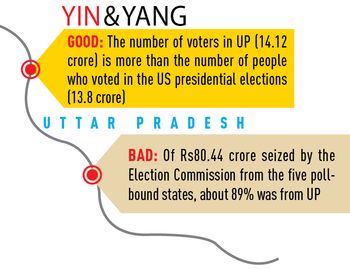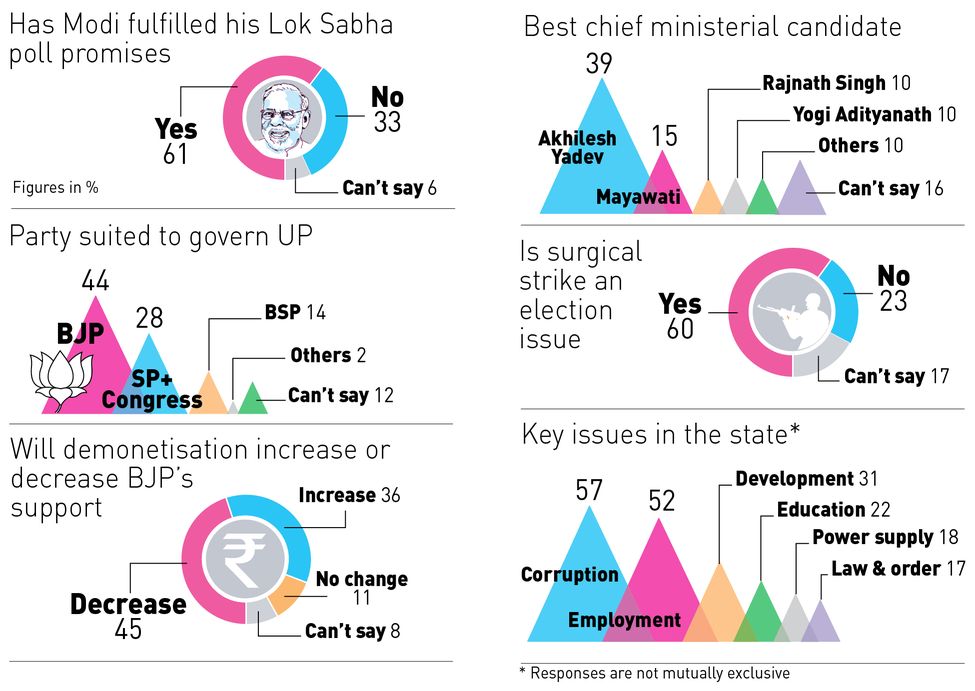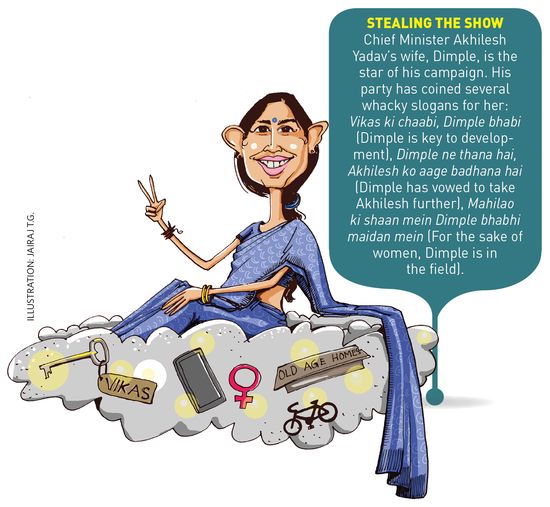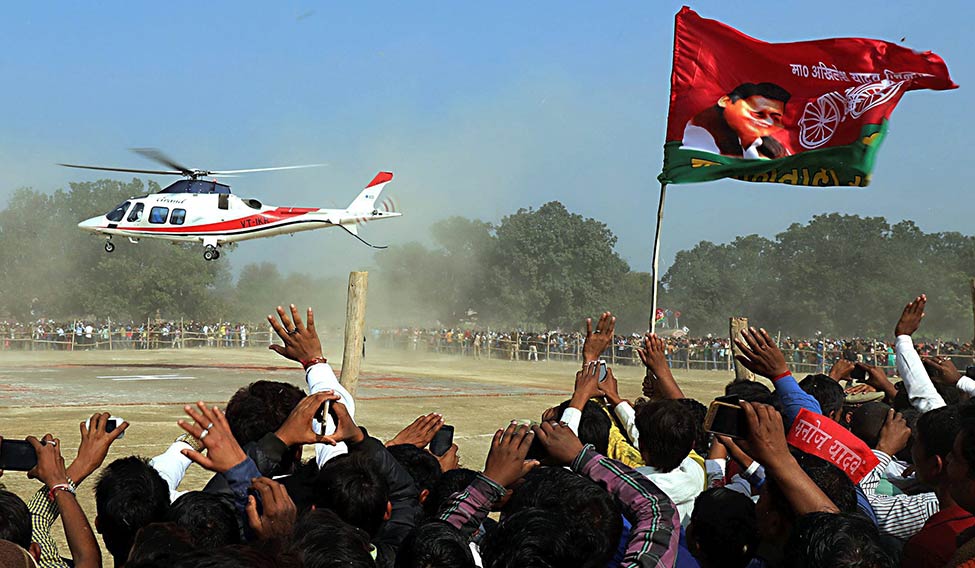When the Samajwadi Party was going through internal turmoil last September, Uttar Pradesh Chief Minister Akhilesh Yadav’s team was busy discussing poll strategy with Steve Jordan, a political expert at Harvard University.
The task of this team was “hi-tech poll management” through social media, mobile phones and person-to-person interaction. The message was simple: propagate good work done by the Akhilesh government.
Meanwhile, Akhilesh was also working on a pre-poll alliance with the Congress. He knew, despite his image of a pro-development leader, his party would struggle to replicate the performance of 2012. “If the Samajwadi Party joins hands with the Congress, we would get 300-plus seats,” he concluded.

The alliance, after some flip-flops, was sealed on January 22. According to the pact, the Samajwadi Party will contest in 298 assembly constituencies, and the Congress in 105 seats, though it had initially demanded 125.
Akhilesh was facing numerous problems created by his adversaries, including his father, Mulayam Singh Yadav. Unfazed, he dealt with them, one after the other. “Come what may, I will distribute the [election] tickets,” he declared, when asked about about the Yadav family feud.
For that, he went on to stage a coup. On January 1, he unseated his father and became national president of the party. He took over complete control of the party and the government. Akhilesh showed that the humble boy who respected and obeyed seniors—and was even described as “weak chief minister”—had come of age.
“The drubbing in the 2014 general elections made him realise that unless he comes out of the shadows of his father and uncle, he won’t be able to sniff victory in 2017,” said a top Samajwadi Party leader.
So, over the past three years, he gradually consolidated his grip on the party and the government. He also took some bold decisions such as expelling his uncle Shvipal Yadav and ministers close to Mulayam.
Was it all stage-managed to burnish Akhilesh’s image and build up momentum? You never know, when it comes to Indian politics!
Just before the Election Commission enforced the code of conduct, Akhilesh announced a slew of projects and sops to woo voters. In one day in December, he launched 300 projects worth Rs 60,000 crore. Around the same time, his government gave 17 OBCs scheduled caste status.
And, among his achievements highlighted are: the Lucknow-Agra Expressway, Samajwadi Purvanchal Expressway, metro services in Lucknow, Kanpur and Varanasi, an international stadium, a super-speciality cancer hospital, the Samajwadi Pension Yojana, and the Kanya Vidya Dhan (scholarship for girl students).
Akhilesh’s poll strategy is three-pronged: project his pro-development image; tom-tom schemes such as distribution of smartphones and laptops among the youth; and exploit the alliance with the Congress.

The alliance would certainly benefit the Samajwadi Party, as it is likely to consolidate Muslim votes in its favour. The party always enjoyed a pro-Muslim image, but, because of the recent family feud, the community was left confused.
The alliance gives BSP supremo Mayawati’s strategy to woo Muslims a big jolt. Mayawati has been banking on dalit-Muslim combination, and has fielded 97 Muslim candidates.
Akhilesh has also given the BJP a jolt, by making a backward caste leader, Naresh Chandra Uttam, the state president of the Samajwadi Party. The BJP has been eyeing a major chunk of non-Yadav backward caste votes, besides its traditional upper caste base.
When Prime Minister Narendra Modi held a massive rally in Lucknow on January 2, he shared the stage with several OBC leaders such as Uma Bharti, Swami Prasad Maurya (who crossed over from the BSP to the BJP), BJP state president Keshav Prasad Maurya, and alliance partner Apna Dal leader Anupriya Patel, who is a Union minister.
The backdrop of the stage, however, had just the party’s lotus symbol—no photos of state leaders.
The rally conveyed two clear messages. One, the BJP is heavily relying on non-Yadav OBC votes. Two, the polls will be fought solely on Modi’s image.
The BJP has been far ahead of its rivals in terms of campaigning. Modi has so far addressed seven public meetings in the state. The party’s Parivartan Yatras (transformation rallies) have covered over 17,000km. The party has constituted committees at nearly 90 per cent booths, and senior BJP leaders have held around 40 major public programmes. The party has also organised at least 200 backward caste conclaves.
BJP national president Amit Shah and state general secretary Sunil Bansal are personally monitoring the poll preparations. At all public meetings, the keywords have been “surgical strike” and demonetisation. The party is also focusing on exposing the ‘black spots’ of the Akhilesh government, such as the poor law and order situation, a streak of communal flare-ups (about 500) and the Yadav family feud.
“Enthusiasm is palpable among workers because we have a very strong government at the Centre, with 70 MPs from Uttar Pradesh,” said an ebullient Keshav Prasad Maurya. “The cadre is determined to recapture power in the state.”

The party, however, is cautious not to repeat the “Bihar mistake”. While in Bihar, it had ‘outsiders’ managing the poll campaign, here the party has given considerable weightage to local leaders.
It has also rewarded turncoats from other parties. A prime example is Rita Bahuguna Joshi, who was Congress state president till recently; she has been given the Lucknow Cantonment seat. The party has also been careful to propitiate its senior state leaders by fielding their relatives.
This election is a prestige issue for Modi and Shah. If they win this round, it will be a big boost for the BJP’s 2019 general election prospects. Also, a victory in Uttar Pradesh means hurdle-free business in the Rajya Sabha.
This election is an acid test for Mayawati, too. After the BSP drew a blank in the 2014 general elections, the former chief minister’s image had hit the nadir. And she has been working overtime to bounce back.
The BSP was the first party to come out with the list of candidates. The list had 87 dalits, 97 Muslims, 106 backward castes and 113 upper caste candidates. Mayawati has clearly pinned her hopes on Muslims.
Naseemuddin Siddiqui, a trusted lieutenant of Mayawati, has been given the task of wooing Muslims, especially in western Uttar Pradesh. He has already held about 500 meetings in the region. “After coming to the power, the Akhilesh government has neglected the interests of Muslims, and they will teach the Samajwadi Party a lesson,” said Mayawati.
So far, the BSP has held over 80 ‘brotherhood rallies’ across the states to woo Muslim and upper caste voters, especially Brahmins. Mayawati’s close aide Satish Chandra Mishra in charge of wooing upper caste voters.
She has also made the demonetisation one of the major poll issues. Party workers in villages have been instructed to convince voters about the ill-effects of demonetisation.
But a major problem which Mayawati has been facing is desertion by her trusted men, who accuse her of turning the party into a “real estate company”.
And, to top it all, the Samajwadi Party-Congress alliance comes as a big blow to Mayawati’s plan of usurping Muslim votes en bloc.
For the Congress, the alliance is a godsend. Four months ago, it talked of going it alone, with the slogan “Sattais saal, UP behal (27 years, since Congress has been out of power, and Uttar Pradesh in a bad shape)”.
The Congress appointed a new state chief, Raj Babbar, and para-dropped former Delhi chief minister Shiela Dikshit as the chief ministerial candidate. The party soon unleashed a scathing attack on the Akhilesh government.
Then came the turnabout. After a series of flip-flops, the Congress accepted to contest 105 seats as an alliance partner of the Samajwadi Party.
Apparently, the Congress realised that party vice president Rahul Gandhi’s khat sabhas (cot meetings) and kisan yatras failed to make any impact on the electorate. The only way left to save itself from a washout was an alliance with the Samajwadi Party.
Thus, despite opposition from state leaders, the party high command sealed the deal, under the watch of Priyanka Vadra.
The Congress’s primary aim is to halt the BJP juggernaut. If it succeeds in it, the party will have a better chance in the 2019 Lok Sabha elections.
“This is not an alliance, but a new beginning,” said Raj Babbar. “Uttar Pradesh will progress with the joint support of the Samajwadi Party and the Congress. Together we will block the BJP’s march in the state.”






